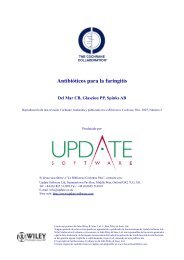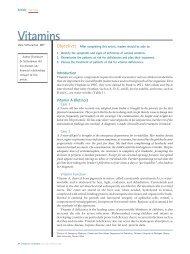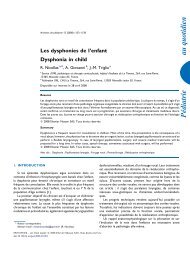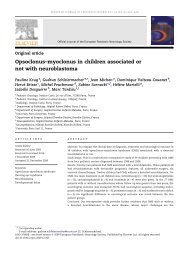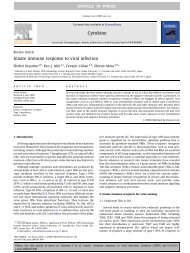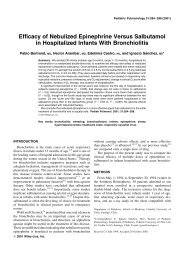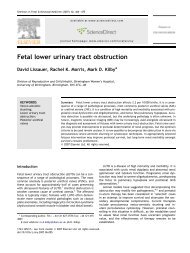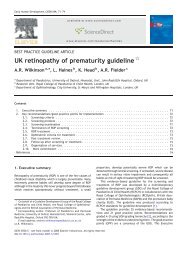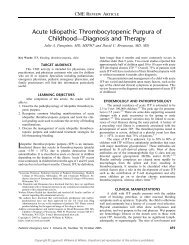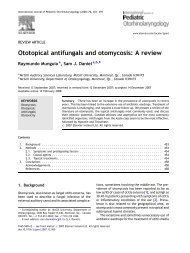Pertussis: a concise historical review including diagnosis ... - sepeap
Pertussis: a concise historical review including diagnosis ... - sepeap
Pertussis: a concise historical review including diagnosis ... - sepeap
Create successful ePaper yourself
Turn your PDF publications into a flip-book with our unique Google optimized e-Paper software.
84 Reviews in Medical Microbiology 2005, Vol 16 No 3<br />
organisms have become non-viable. In patients with<br />
clinical symptoms of B. pertussis infection and positive<br />
serology sensitivity of PCR and culture is low (21 and 7%,<br />
respectively) but specificity of both is 98% [73].<br />
In adolescents and adults culture or PCR is not useful<br />
when disease duration is longer than 3–4 weeks [73]. In<br />
contrast in non-vaccinated or partially vaccinated young<br />
children culture or PCR is useful in any stage of the<br />
disease as they have an immature mucosal immune<br />
response and therefore a slower eradication of the<br />
bacteria.<br />
As the usefulness of PCR and culture declines with<br />
increasing disease duration, serology becomes more<br />
important. Already in 1911 Bordet and Gengou published<br />
the first serological methods, detecting agglutinating<br />
antibodies to whole B. pertussis cells [74]. This<br />
remained the hallmark of pertussis serology for more than<br />
70 years [75]. In the 1980s various enzyme immunoassays<br />
were developed, and presently immunoglobulin G against<br />
pertussis toxin (IgG-PT) is the most used and validated<br />
test to prove B. pertussis infection [72,75]. IgG-PT is only<br />
produced after infection with B. pertussis, and not other<br />
Bordetella species, nor are any cross-reactions described. In<br />
newborn infants and after vaccination against B. pertussis<br />
IgG-PT should be looked at with caution because of<br />
transplacental transfer or induction by vaccination [72].<br />
After the fourth vaccination with the Dutch vaccine there<br />
is only a temporary and small increase and in both<br />
instances there is a fast decrease [76]. However, other<br />
whole-cell vaccines and acellular vaccines might induce<br />
higher IgG-PT levels [45,77]. Antibodies against other<br />
antigens such as pertactin, fimbriae and filamentous<br />
hemagglutinin (FHA) are also available, but less validated,<br />
and are also produced in reaction to infections with other<br />
Bordetella species and perhaps other related bacteria. IgG-<br />
PT, appearing as late as week 3 of illness reaches its peak<br />
approximately 4.5 weeks after infection, but is retarded in<br />
very young children (< 1 year). Serology for B. pertussis is<br />
considered positive by the finding of a significant, at least<br />
a fourfold increase of IgG antibodies to pertussis toxin<br />
(IgG-PT) in paired sera to a level of at least 20 U/ml. This<br />
hampers the <strong>diagnosis</strong> of B. pertussis infection, since many<br />
patients present themselves later in their disease, having<br />
already high levels of IgG-PT without showing a significant<br />
increase.<br />
Differential <strong>diagnosis</strong><br />
Especially in immunized people, or in those who suffered<br />
earlier from pertussis infection, the atypical complaints<br />
may be difficult to distinguish from infection by other<br />
pathogens, such as adenovirus, influenzavirus, parainfluenza<br />
viruses, respiratory syncytial virus, Chlamydia<br />
pneumoniae or Mycoplasma pneumoniae, which may cause a<br />
pertussis-like syndrome [17–20,23]. Also mixed infections<br />
may complicate the <strong>diagnosis</strong> [21,22].<br />
Treatment and prevention<br />
Although immunization against B. pertussis infection has<br />
caused a great reduction in the incidence of pertussis,<br />
outbreaks still occur, even in countries with high<br />
vaccination coverage. Erythromycin, 40–50 mg/kg per<br />
day for 10–14 days, usually considered the treatment of<br />
choice, will eliminate viable B. pertussis organisms from<br />
the respiratory tract within a few days [11,78–81]. A<br />
7-day course of erythromycin has proven to be as<br />
efficacious as a 14-day course [82]. Newer macrolides<br />
such as azithromycin, 10 mg/kg per day for 3 or 5 days<br />
[79,83], or 10 mg/kg the first day and 5 mg/kg per day<br />
for 4 days [81,83], or clarithromycin, 10–15 mg/kg per<br />
day for 7 days [79,80] have also been shown to be effective<br />
in the treatment of pertussis with fewer side effects than<br />
erythromycin. Erythromycin-resistant strains of B. pertussis<br />
have been isolated, but this seems to be very<br />
uncommon [84,85]. Although rare, the use of erythromycin<br />
in young infants is associated with hypertrophic<br />
pyloric stenosis [86,87]. An alternative to erythromycin is<br />
trimethoprim–sulfamethoxazole, 6–10 mg trimethoprim/kg<br />
per day for 14 days [88]. Fluoroquinolones<br />
have good in vitro activity against both B. pertussis and<br />
B. parapertussis and may be useful in the treatment of<br />
B. pertussis infection, although there are no supporting<br />
clinical data at present [89].<br />
Human hyperimmune pertussis globulin is still used<br />
occasionally [90,91]. Further treatment is symptomatic.<br />
High altitude, flying or hypobaric therapy have been<br />
suggested as effective treatments for the cough [92–94].<br />
During the paroxysmal phase of the disease, eradication of<br />
the bacteria by antimicrobial drugs, such as erythromycin,<br />
will not significantly change the clinical course, although<br />
there is some clinical evidence that some macrolides<br />
might reduce cough [95].<br />
Although it is better for susceptible children (unimmunized<br />
children without a history of whooping cough)<br />
to avoid contact with pertussis patients during the first 4<br />
weeks of their illness, this is often difficult to achieve.<br />
Exposed unimmunized children are given a macrolide for<br />
10 days after contact is discontinued or after the patient<br />
ceases to be contagious. Exposed immunized children<br />
younger than 4 years are most probably protected but<br />
protection may be enhanced by macrolides or by a booster<br />
dose of acellular pertussis vaccine [96].<br />
Vaccination<br />
Currently, approximately 80% of the world’s children are<br />
vaccinated against pertussis, most of whom have received




